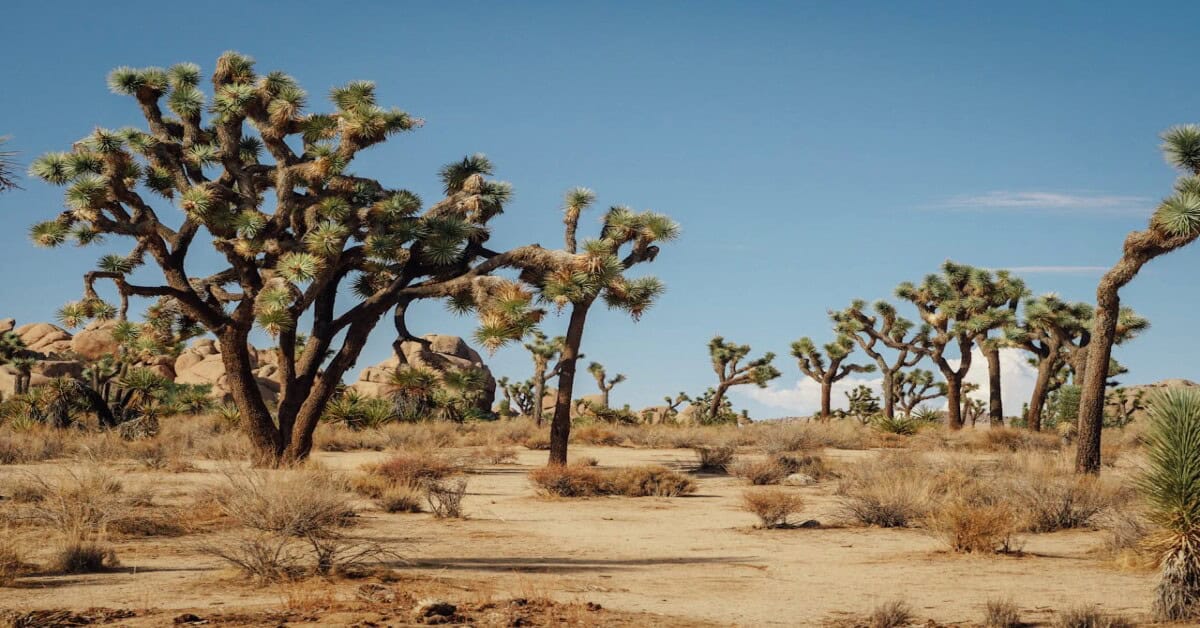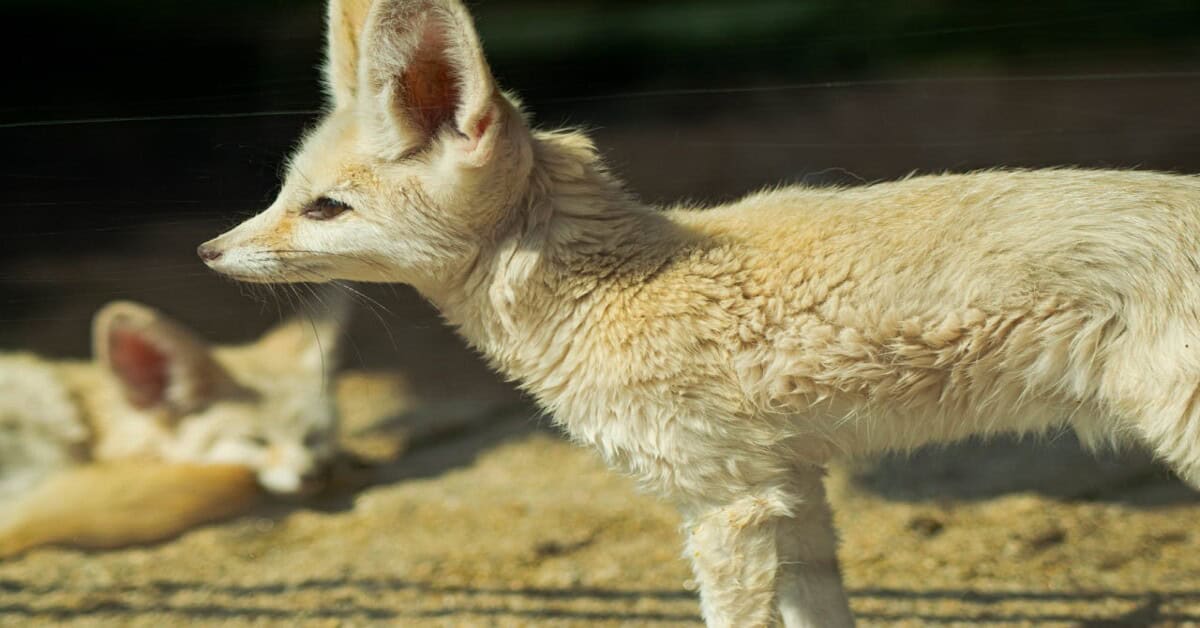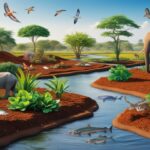A desert ecosystem is a unique environment defined by its dry, arid conditions and minimal rainfall. Covering about one-third of Earth’s land area, deserts are found on every continent, from the vast Sahara in Africa to the cold Gobi in Asia. The characteristics of the desert ecosystem go beyond just sand and heat; they include a wide range of plants, animals, and fascinating adaptations.
Deserts may appear lifeless at first glance, but they support a surprising variety of life forms specially adapted to harsh conditions. For example, cacti store water in thick stems, while animals like foxes and reptiles conserve moisture and avoid the sun’s intense heat.
These ecosystems also play an essential role in maintaining biodiversity and provide valuable resources for people and wildlife alike.
The desert ecosystem’s climate is defined by its extreme dryness and intense temperature variations. Most deserts receive less than 10 inches of rainfall each year, creating very dry conditions. However, the temperatures in deserts can vary greatly. During the day, temperatures can soar to over 100°F, especially in hot deserts like the Sahara. At night, they can plunge drastically, sometimes even below freezing. This sharp temperature shift happens because dry air retains little heat once the sun sets.
Desert Ecosystem
A desert ecosystem is a unique environment where life has adapted to extreme conditions. Deserts are defined by low rainfall, high temperatures, and dry air, creating challenging living conditions for plants and animals.
These ecosystems are usually found in areas with less than 10 inches of rain annually, like the Sahara, Mojave, and Gobi deserts.
Despite the harsh climate, many species have evolved to thrive here. For example, cacti store water in their thick stems, while animals like the fennec fox are active at night to avoid daytime heat.
Desert ecosystems showcase remarkable adaptations and play essential roles in supporting biodiversity, offering habitats and resources uniquely suited to their conditions.

Climate Characteristics of Desert Ecosystems
Desert ecosystems are known for their dry climate, where rain is extremely scarce. Most deserts receive less than 10 inches of rainfall annually, making moisture a rare resource. This low rainfall contributes to the dry and arid conditions, where plants and animals have adapted to survive on minimal water.
However, not all deserts are the same. Hot deserts, like the Sahara, experience intense daytime heat, while cold deserts, such as the Gobi, have freezing winter temperatures. Regardless of type, deserts share one key characteristic: a climate with very little rainfall.
Besides low rainfall, deserts are also known for extreme temperature fluctuations. During the day, temperatures can reach over 100°F in hot deserts, which makes survival challenging. But as the sun sets, temperatures drop quickly, sometimes reaching near freezing.
This rapid cooling happens because the dry desert air does not trap heat once the sun goes down. Therefore, many desert animals are nocturnal, resting during the heat of the day and coming out at night when it is cooler.
Desert climates also show seasonal temperature changes. For example, summer temperatures in hot deserts can be scorching, making survival difficult even for desert-adapted species. In winter, some deserts, especially the cold ones, can experience bitterly cold nights.
Antarctica, considered the world’s largest cold desert, has freezing conditions year-round, but it still qualifies as a desert because it receives so little precipitation. These seasonal and daily temperature variations create a unique and challenging environment in which only specialized plants and animals can thrive.
Soil Characteristics in Desert Ecosystems
Desert soils are often sandy or rocky, with minimal organic matter. Unlike fertile soils, which contain nutrients from decaying plants and animals, desert soils are poor in nutrients.
Furthermore, desert soils are loosely packed, meaning water drains quickly, leaving little for plants to absorb. This composition is common in hot deserts like the Sonoran Desert, where soil often consists of sand, gravel, or rock, with few nutrients available.
The poor water retention of desert soil is another challenge for desert plants. When rain does fall, it quickly seeps through the sand or rocks, which cannot hold moisture for long.
However, some plants have adapted by growing deep roots that reach underground water sources. Cacti, for example, can store water in their stems, helping them survive long dry spells. Therefore, even with low water retention, desert soil plays a role in supporting unique vegetation.
Although desert soil is not fertile, it is essential to the desert ecosystem. Some plants use the soil’s structure for stability and grow deep roots to find water and nutrients.
Animals such as lizards and insects also rely on the soil for burrows, which provide shelter from extreme temperatures. In this way, desert soil, while not rich in nutrients, is still vital for the survival of plants and animals that have adapted to thrive in these arid landscapes.
Also Read: Benefits of Wetlands for the Environment
Flora of Desert Ecosystems
In desert ecosystems, plants have adapted to thrive in extreme conditions, particularly with limited water. Characteristics of desert plants often include drought resistance, meaning they can survive long periods without rainfall.
These plants have developed unique traits that allow them to make the most of the scarce water available. For example, they tend to grow slowly, conserving energy and resources over time. These adaptations help them endure the harsh desert environment, where water is always in short supply.
One common adaptation in desert flora is deep root systems, which allow plants to reach water stored deep underground. Some plants, like the mesquite tree, can grow roots that extend as far as 80 feet below the surface. Additionally, many desert plants have small or waxy leaves, which reduce water loss by limiting evaporation.
Some plants, such as cacti, store water in their thick stems, allowing them to survive long dry spells without additional moisture. These traits are essential for survival in the desert ecosystem, where every drop of water counts.
Examples of desert plants include cacti, succulents, and shrubs, each with unique adaptations. Cacti, for instance, have spines instead of leaves, which helps reduce water loss and protect them from herbivores. Succulents, like aloe vera, store water in their fleshy leaves, providing a reserve for dry periods.
These plants play an important role in desert ecosystems by providing food and shelter to various animals. Together, the characteristics of desert plants enable them to survive and contribute to the ecosystem.

Fauna of Desert Ecosystems
Desert animals also have impressive adaptations that help them endure extreme conditions. Many desert animals are nocturnal, meaning they are active at night when temperatures are cooler. By avoiding the sun’s heat, they conserve water and reduce the risk of dehydration.
For example, the fennec fox and desert rodents are nocturnal, emerging from their burrows only after sunset. Nocturnal behavior is a common adaptation in desert ecosystems, allowing animals to cope with high daytime temperatures.
In addition to nocturnality, desert animals possess physical adaptations to survive in arid environments. Many have specialized kidneys that conserve water by producing highly concentrated urine. Camels, for example, store fat in their humps, which can be converted into water and energy when food and water are scarce.
Certain reptiles, like the desert tortoise, can go for months without drinking, surviving on the water stored in their bodies. These adaptations make it possible for animals to live in an ecosystem with unpredictable and scarce water sources.
Other adaptations include burrowing and thermoregulation, which help desert animals regulate their body temperature. Small animals like lizards and insects often burrow into the ground to escape the daytime heat. This behavior protects them from the sun and provides a cooler environment.
Furthermore, animals like jackrabbits have large ears that help release body heat. These survival strategies reflect the characteristics of desert ecosystems, where extreme conditions shape the behaviors and physical traits of wildlife.

Unique Adaptations in Desert Ecosystems
Plants and animals in desert ecosystems have developed unique adaptations to thrive in such extreme habitats. Many plants use water storage, deep roots, and waxy leaves to survive in low-rainfall environments. For example, certain cacti and succulents store water in their stems, allowing them to endure long dry spells.
Likewise, desert animals have evolved strategies like water conservation, burrowing, and nocturnal habits to adapt to their environment. These traits are essential for survival in a place where water is scarce, and temperatures are extreme.
Symbiotic relationships and unique survival strategies also play a role in the desert. For example, some birds and mammals rely on specific plants for food, shelter, and water, creating a balanced ecosystem.
Certain insects, like bees, help pollinate desert plants, ensuring the growth of vegetation and food sources for other animals. These interactions show how plants and animals depend on each other to thrive, helping maintain the delicate balance of the desert ecosystem.
The ecological significance of these adaptations in the desert ecosystem is profound. Each plant and animal’s survival strategy allows it to play a role in maintaining the ecosystem’s health and stability.
Adaptations like drought resistance in plants and water conservation in animals make life sustainable even in the harshest conditions. Together, the characteristics of the desert ecosystem highlight a resilient community that has learned to thrive against all odds.
Importance of Desert Ecosystem
Desert ecosystems are vital to global biodiversity and have unique roles in supporting plant and animal life. These regions house species that have evolved distinct adaptations, allowing them to survive in harsh conditions.
Desert plants and animals contribute to the diversity of life on Earth, often displaying traits unseen in other ecosystems. Additionally, deserts play a role in the carbon cycle by storing carbon in soil and sparse vegetation, helping to regulate global carbon levels.
Therefore, deserts are essential for both biodiversity and environmental balance, offering insights into the resilience and adaptability of life.
Deserts also have significant economic value. Many deserts are rich in valuable minerals and resources, making mining a vital industry in these areas. Tourism in desert regions, such as the Sahara and American Southwest, attracts millions of visitors each year, creating jobs and revenue for local communities.
Furthermore, deserts hold potential for renewable energy projects, especially solar power, due to their ample sunlight. Besides these industries, deserts contribute to scientific research, offering valuable insights into adaptation, climate resilience, and survival strategies.
By understanding these aspects, scientists can find clues about how life on Earth adapts to extreme environments.
Threats to Desert Ecosystems
Despite their importance, desert ecosystems face significant threats due to human activities and environmental changes. Overgrazing by livestock damages fragile desert plants, leading to soil degradation and erosion.
Resource extraction, such as mining and drilling, disrupts habitats and can pollute water sources, harming native wildlife.
Climate change poses additional risks, as higher temperatures and changing rainfall patterns can increase desertification, transforming nearby areas into deserts. This loss of habitat and native species reduces biodiversity and weakens the ecosystem.
Conservation efforts are crucial to protecting desert ecosystems from these threats. By promoting sustainable practices, such as responsible grazing and controlled resource extraction, we can help preserve desert habitats.
Conservation efforts also include protecting endangered species and restoring damaged lands to maintain the ecological balance. Safeguarding desert ecosystems is essential to preserving biodiversity, supporting unique species, and retaining the natural beauty of these remarkable landscapes.
Conclusion
Desert ecosystems are truly unique, marked by their dry climates, extreme temperatures, and specialized flora and fauna. These environments play a crucial role in supporting biodiversity, housing species that have evolved to survive harsh conditions.
Deserts demonstrate the remarkable ways life can thrive even in adversity. Beyond their biological significance, deserts hold ecological and economic value. They help regulate carbon levels and offer resources like minerals, tourism opportunities, and renewable energy potential.
Deserts are also valuable for scientific research, offering lessons on adaptation and resilience. Protecting these ecosystems is essential for preserving their natural beauty and biodiversity.
By appreciating the uniqueness of deserts, we can better understand their importance and support efforts to conserve them. Sustainable practices and conservation can ensure that these ecosystems continue to thrive for future generations.






